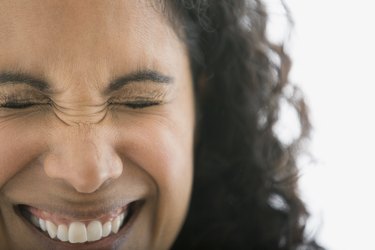
Botox is the brand name of the formula containing clostridium botulinum, a toxin used to treat weakened muscles, facial twitches and uncontrolled blinking, report doctors at the Cleveland Clinic.
Cosmetic surgeons inject Botox into areas of the skin to reduce wrinkles and facial creases. The effects of these injections last about four to six months. Exercise after Botox usually is tempered for a short period of time.
Video of the Day
Video of the Day
Read more: Botox for Under Eye Wrinkles
Common Side Effects
The side effects of the toxic injection usually don't last more than 24 to 48 hours for most patients. During that time, patients may require more rest and less exertion due to headaches. Aerobic exercise may exacerbate the headaches and should be avoided for a couple days.
Other side effects and potential complications include pain at the injection site, flu-like symptoms, and dry eye or excessive tears, according to Mayo Clinic.
Adverse Side Effects
The potential for adverse affects from the drug can be worsened by exercises that cause patients to sweat. Drooping eyelid is caused by the migration of the Botox to other areas of the face where it can pool and create more extensive paralysis. Drooling and a crooked smile can also occur if the Botox migrates, says Mayo Clinic.
You will likely be warned not to rub your face for at least two hours and to avoid activities that cause the face to sweat profusely, according to Sun Valley Dental Centre. To avoid Botox migration, patients also are urged to avoid exercises for at least three or four hours that require them to lie down.
Botox is not recommended for pregnant or breastfeeding women or people who have pre-existing neurological conditions.
Exercise After Botox
To manipulate the Botox to enter the muscles more deeply, you might be encouraged to perform facial exercises without touching your face.
Contract the muscles around the area where the Botox was injected and hold for five seconds, then release. Tense these muscles by squeezing them tightly and holding.
Other movements may include squinting, frowning or pursing the lips, depending on where the shots were placed. Repeat the contraction exercises often for about four hours following the procedure.
Noncosmetic Botox
Other exercise considerations must be made for patients who receive Botox injections for muscular complications in other areas of the body. Stretching the injected muscles immediately following injections is important for patients who receive treatments for spastic muscles, such as those with muscular dystrophy or cerebral palsy.
Stretching should be slow and consistent, avoiding pulling or sudden tugging. Other patients receiving Botox treatments for leg muscles may require additional physical therapy for walking properly after the spasms have reversed. Walkers, grab bars and other balancing devices should be incorporated to assist with walking at first.
Warnings and Precautions
In addition to possibly pushing the toxin to unintended areas of the face, there are other consequences of performing vigorous exercise the day before the injections and for one or two days following a Botox treatment. By elevating the heart rate and blood pressure, patients may increase the incidence of bruising at the site of the injection.
Read more: Are There Natural Alternatives to Botox?